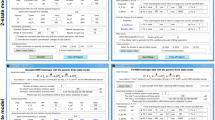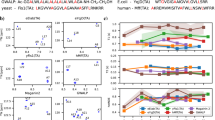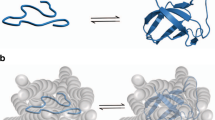Abstract
Solution NMR spectroscopy is an extremely powerful technology for the study of biomolecular dynamics and site-specific molecular interactions. An important limitation in the past has been molecule size, with molecular weights of targets seldom exceeding 50 kDa. New labeling technology and NMR experiments are changing this paradigm so that applications for investigating supramolecular complexes are starting to become feasible. Here we describe a strategy developed in our laboratory that involves the use of labeled methyl groups of isoleucine, leucine and valine residues in proteins as probes, along with experiments that significantly enhance the lifetimes of the resulting signals. We describe the application of these methods to a number of systems with molecular weights in the hundreds of kilodaltons.
This is a preview of subscription content, access via your institution
Access options
Subscribe to this journal
Receive 12 print issues and online access
$259.00 per year
only $21.58 per issue
Buy this article
- Purchase on Springer Link
- Instant access to full article PDF
Prices may be subject to local taxes which are calculated during checkout






Similar content being viewed by others
References
Wüthrich, K. NMR of Proteins and Nucleic Acids (John Wiley & Sons, New York, 1986).
Bax, A. Weak alignment offers new NMR opportunities to study protein structure and dynamics. Protein Sci. 12, 1–16 (2003).
Wider, G. & Wüthrich, K. NMR spectroscopy of large molecules and multimolecular assemblies in solution. Curr. Opin. Struct. Biol. 9, 594–601 (1999).
Bax, A. Multidimensional nuclear magnetic resonance methods for protein studies. Curr. Opin. Struct. Biol. 4, 738–744 (1994).
Gardner, K.H. & Kay, L.E. The use of 2H, 13C, 15N multidimensional NMR to study the structure and dynamics of proteins. Annu. Rev. Biophys. Biomol. Struct. 27, 357–406 (1998).
Farmer, B.T. & Venters, R.A. in Biological Magnetic Resonance (eds. Krishna, N.R. & Berliner, L.J.) 75–120 (Kluwer/Plenum, New York, 1998).
Pervushin, K., Riek, R., Wider, G. & Wüthrich, K. Attenuated T2 relaxation by mutual cancellation of dipole-dipole coupling and chemical shift anisotropy indicates an avenue to NMR structures of very large biological macromolecules in solution. Proc. Natl. Acad. Sci. USA 94, 12366–12371 (1997).
Fiaux, J., Bertelsen, E.B., Horwich, A.L. & Wüthrich, K. NMR analysis of a 900K GroEL-GroES complex. Nature 418, 207–221 (2002).
Tjandra, N. & Bax, A. Direct measurement of distances and angles in biomolecules by NMR in a dilute liquid crystalline medium. Science 278, 1111–1114 (1997).
Tolman, J.R., Flanagan, J.M., Kennedy, M.A. & Prestegard, J.H. Nuclear magnetic dipole interactions in field-oriented proteins: information for structure determination in solution. Proc. Natl. Acad. Sci. USA 92, 9279–9283 (1995).
Tugarinov, V., Choy, W.Y., Orekhov, V.Y. & Kay, L.E. Solution NMR-derived global fold of a monomeric 82-kDa enzyme. Proc. Natl. Acad. Sci. USA 102, 622–627 (2005).
Palmer, A.G., Williams, J. & McDermott, A. Nuclear magnetic resonance studies of biopolymer dynamics. J. Phys. Chem. 100, 13293–13310 (1996).
Mittermaier, A. & Kay, L.E. New tools provide new insights in NMR studies of protein dynamics. Science 312, 224–228 (2006).
Goto, N.K. & Kay, L.E. New developments in isotope labeling strategies for protein solution NMR spectroscopy. Curr. Opin. Struct. Biol. 10, 585–592 (2000).
Clore, G.M. & Gronenborn, A.M. Structures of larger proteins in solution: three- and four-dimensional heteronuclear NMR spectroscopy. Science 252, 1390–1399 (1991).
LeMaster, D.M. & Richards, F.M. NMR sequential assignment of Escherichia coli thioredoxin utilizing random fractional deuteration. Biochemistry 27, 142–150 (1988).
Grzesiek, S., Anglister, J., Ren, H. & Bax, A. 13C line narrowing by 2H decoupling in 2H/13C/15N-enriched proteins. Applications to triple resonance 4D J-connectivity of sequential amides. J. Am. Chem. Soc. 115, 4369–4370 (1993).
Tugarinov, V. & Kay, L.E. An isotope labeling strategy for methyl TROSY spectroscopy. J. Biomol. NMR 28, 165–172 (2004).
Janin, J., Miller, S. & Chothia, C. Surface, subunit interfaces and interior of oligomeric proteins. J. Mol. Biol. 204, 155–164 (1988).
Dalvit, C. & Stockman, B.J. NMR screening techniques in drug discovery and drug design. Prog. Nucl. Magn. Reson. Spectrosc. 41, 187–231 (2002).
Gardner, K.H., Rosen, M.K. & Kay, L.E. Global folds of highly deuterated, methyl protonated proteins by multidimensional NMR. Biochemistry 36, 1389–1401 (1997).
Zheng, D. et al. Automated protein fold determination using a minimal NMR constraint strategy. Protein Sci. 12, 1232–1246 (2003).
Nicholson, L.K. et al. Dynamics of methyl groups in proteins as studied by proton-detected 13C NMR spectroscopy. Application to the leucine residues of staphylococal nuclease. Biochemistry 31, 5253–5263 (1992).
Tugarinov, V. & Kay, L.E. Quantitative 13C and 2H NMR relaxation studies of the 723-residue enzyme malate synthase G reveal a dynamic binding interface. Biochemistry 44, 15970–15977 (2005).
Goto, N.K., Gardner, K.H., Mueller, G.A., Willis, R.C. & Kay, L.E. A robust and cost-effective method for the production of Val, Leu, Ile (δ1) methyl-protonated 15N-,13C-,2H-labeled proteins. J. Biomol. NMR 13, 369–374 (1999).
Lowe, J. et al. Crystal structure of the 20S proteasome from the archaeon T. acidophilum at 3.4 Å resolution. Science 268, 533–539 (1995).
McCaldon, P. & Argos, P. Oligopeptide biases in protein sequences and their use in predicting protein coding regions in nucleotide sequences. Proteins 4, 99–122 (1988).
Ernst, R.R., Bodenhausen, G. & Wokaun, A. Principles of Nuclear Magnetic Resonance in One and Two Dimensions (Oxford University Press, Oxford, UK, 1987).
Tugarinov, V., Hwang, P., Ollerenshaw, J. & Kay, L.E. Cross-correlated relaxation enhanced 1H-13C NMR spectroscopy of methyl groups in very high molecular weight proteins and protein complexes. J. Am. Chem. Soc. 125, 10420–10428 (2003).
Sprangers, R., Gribun, A., Hwang, P.M., Houry, W.A. & Kay, L.E. Quantitative NMR spectroscopy of supramolecular complexes: dynamic side pores in ClpP are important for product release. Proc. Natl. Acad. Sci. USA 102, 16678–16683 (2005).
Sprangers, R. & Kay, L.E. Quantitative dynamics and binding studies of the 20S proteasome by NMR. Nature 445, 618–622 (2007).
Kainosho, M. et al. Optimal isotope labelling for NMR protein structure determinations. Nature 440, 52–57 (2006).
Velyvis, A., Yang, Y.R., Schachman, H.K. & Kay, L.E. A solution NMR study showing that active site ligands and nucleotides directly perturb the allosteric equilibrium in aspartate transcarbamoylase. Proc. Natl. Acad. Sci. USA (2007).
Schachman, H.K. Can a simple model account for the allosteric transition of aspartate transcarbamoylase? J. Biol. Chem. 263, 18583–18586 (1988).
Wang, J., Harting, J.A. & Flanagan, J.M. The structure of ClpP at 2.3 Å resolution suggests a model for ATP-dependent proteolysis. Cell 91, 447–456 (1997).
Ortega, J., Singh, S.K., Ishikawa, T., Maurizi, M.R. & Steven, A.C. Visualization of substrate binding and translocation by the ATP-dependent protease, ClpXP. Mol. Cell 6, 1515–1521 (2000).
Choi, K.H. & Licht, S. Control of peptide product sizes by the energy-dependent protease ClpAP. Biochemistry 44, 13921–13931 (2005).
Farrow, N.A., Zhang, O., Forman-Kay, J.D. & Kay, L.E. A heteronuclear correlation experiment for simultaneous determination of 15N longitudinal decay and chemical exchange rates of systems in slow equilibrium. J. Biomol. NMR 4, 727–734 (1994).
Montelione, G.T. & Wagner, G. 2D chemical-exchange NMR-spectroscopy by proton detected heteronuclear correlation. J. Am. Chem. Soc. 111, 3096–3098 (1989).
Palmer, A.G., III, Grey, M.J. & Wang, C. Solution NMR spin relaxation methods for characterizing chemical exchange in high-molecular-weight systems. Methods Enzymol. 394, 430–465 (2005).
Korzhnev, D.M., Kloiber, K., Kanelis, V., Tugarinov, V. & Kay, L.E. Probing slow dynamics in high molecular weight proteins by methyl-TROSY NMR spectroscopy: application to a 723-residue enzyme. J. Am. Chem. Soc. 126, 3964–3973 (2004).
Gribun, A. et al. The ClpP double ring tetradecameric protease exhibits plastic ring-ring interactions, and the N termini of its subunits form flexible loops that are essential for ClpXP and ClpAP complex formation. J. Biol. Chem. 280, 16185–16196 (2005).
Goldberg, A.L., Gaczynska, M., Grant, E., Michalek, M. & Rock, K.L. Functions of the proteasome in antigen presentation. Cold Spring Harb. Symp. Quant. Biol. 60, 479–490 (1995).
Pickart, C.M. & Cohen, R.E. Proteasomes and their kin: proteases in the machine age. Nat. Rev. Mol. Cell Biol. 5, 177–187 (2004).
Goldberg, A.L. Protein degradation and protection against misfolded or damaged proteins. Nature 426, 895–899 (2003).
Tugarinov, V., Sprangers, R. & Kay, L.E. Probing side-chain dynamics in the proteasome by relaxation violated coherence transfer NMR spectroscopy. J. Am. Chem. Soc. 129, 1743–1750 (2007).
Gavin, A.C. et al. Proteome survey reveals modularity of the yeast cell machinery. Nature 440, 631–636 (2006).
Whitby, F.G. et al. Structural basis for the activation of 20S proteasomes by 11S regulators. Nature 408, 115–120 (2000).
Acknowledgements
This work is supported by grants from the Natural Sciences and Engineering Research Council of Canada and the Canadian Institutes of Health Research (CIHR). R.S. and A.V. acknowledge post-doctoral support from a CIHR training grant in protein folding and disease and a CIHR post-doctoral fellowship, respectively. L.E.K. is the recipient of a Canada Research Chair in Biochemistry.
Author information
Authors and Affiliations
Corresponding author
Ethics declarations
Competing interests
The authors declare no competing financial interests.
Rights and permissions
About this article
Cite this article
Sprangers, R., Velyvis, A. & Kay, L. Solution NMR of supramolecular complexes: providing new insights into function. Nat Methods 4, 697–703 (2007). https://doi.org/10.1038/nmeth1080
Issue Date:
DOI: https://doi.org/10.1038/nmeth1080
This article is cited by
-
Dynamic interactions between E-cadherin and Ankyrin-G mediate epithelial cell polarity maintenance
Nature Communications (2023)
-
Methyl probes in proteins for determining ligand binding mode in weak protein–ligand complexes
Scientific Reports (2022)
-
Membrane perturbation by lipidated Atg8 underlies autophagosome biogenesis
Nature Structural & Molecular Biology (2021)
-
Molecular chaperones and their denaturing effect on client proteins
Journal of Biomolecular NMR (2021)
-
Architecture of the flexible tail tube of bacteriophage SPP1
Nature Communications (2020)



